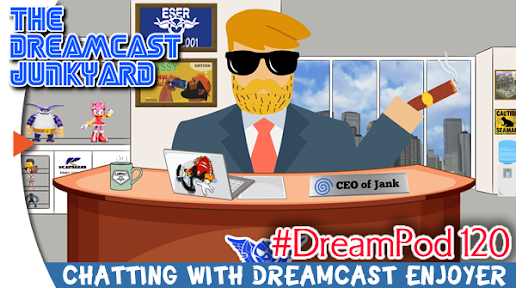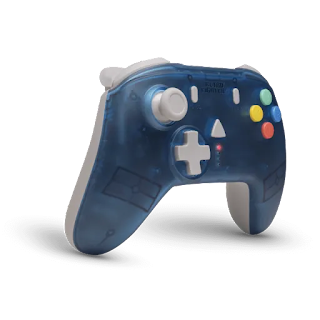With Driving Strikers, LD-2K and Reality Jump have taken Sega’s iconic “why don’t we play together?” slogan to heart, producing the first online multiplayer Dreamcast game since 2002. Whatever your assessment of the gameplay itself may be, this is a monumental achievement - probably about as significant a leap as we are likely to see within our niche community. Commercial indie releases have been hitting the shelves for two decades now, and although there have been some phenomenal entries made to the Dreamcast’s library during that time, no one had mustered the courage to tackle what is probably the keystone of the console’s identity; online play. That is, until recently.
Luke Benstead and David Reichelt, the former of which invented the popular DreamPi method for connecting your Dreamcast to the internet, have been plugging away at the development of Driving Strikers, a fast-paced ‘car football’ game, for several years now (Rocket League? Never heard of it, mate). The duo, assisted by a handful of others, and with WAVE Game Studios on board as publisher, finalised the game back in June and physical copies have recently begun landing on doormats. Regular scene-watchers may already be familiar with the fundamental concept and overall design given that several demos have been dropped during the game’s developmental lifespan. For those that are still uninitiated though, it’s really quite simple: you take control of a car in a football match, and are tasked with scoring more goals than your opponents within rounds of a few minutes at time. You drive. You strike. It’s all in the name! Well actually, you can boost and jump too, but Boosted-Jumping-Driving Strikers would’ve been a bit of a mouthful.
 |
| All screenshots provided by Luke Benstead. |
Those who have played the demos will immediately notice that the final commercial release of Driving Strikers is significantly expanded and improved upon when compared to those earlier builds. The most important change is undoubtedly in the handling of the cars, which are directed via your analog stick or D-pad. To be honest, in the demos I found controlling my vehicle to be virtually impossible, resulting in a chaotic experience replete with own goals that would make Frank Sinclair blush. In the final product though, the cars are much more manoeuvrable, allowing for more clearly defined defensive and attacking plays which are greatly rewarding when they pay off - especially so when you can rub it in the face of a human opponent. Matches are still quite hectic in nature, but now to a degree that suits, and while the gameplay is intuitive enough for total beginners it also has space for the development of skill from practice.
The arenas available to players, four regular and two unlockable, are diverse in their design, ranging from a serene beach (which looks more Seychelles than Skegness) to a dingy cobblestone castle. The distinct earworm-laden music that accompanies each stage is a particular highlight, with the Christmas stage track acting like a homage to the classic Dubstep Santa. If the stadia had differed a little more in their shape and terrain, and if the teams you choose from had material differences in their operation (speed, boost, strength etc.), then that may have helped spice things up a little more, but understandably for a game like this, boundaries need to be kept manageable.
The ‘league’ mode featured in the commercial release definitely adds a little longevity to the game (and must be traversed if you want to unlock one of the arenas) but fundamentally Driving Strikers is all about multiplayer - whether that be in person or online. What can at times be a bit of a dull experience when played solo becomes infinitely more fun when the competitive human connection is thrown in. If you are blessed enough to be able to call on four friends to cram round a screen, then Driving Strikers will easily give you the same vibes as local multiplayer classics of old.
 |
| Best game ever. No bias, or anything. |
Of course, if your Dreamcast is connected to the internet, then playing online is a must. However, as much of a watershed achievement as this feature is, it does come with some caveats. When it runs smoothly, the online multiplayer experience is fantastic, and you’ll find yourself happily burning through half a dozen rounds before you need to take a breather. Unfortunately though, the lag experienced by DreamPi users can disrupt things, and it seems to be a bit of a lottery as to whether you have no lag, a noticeable yet serviceable level, or a big fat dose. LD-2K and WAVE do acknowledge this, recommending in the manual that hosts should be using a Broadband Adapter wherever possible. The times I have played with a BBA have certainly been noticeably better, but the reality is that this peripheral remains expensive and far less widely used than the DreamPi. Aside from the lag, the game’s online mode does have other occasional hiccups too, whether that be freezing (requiring a console reset) or potential difficulties with the login screen.
No doubt some folks may feel a little aggrieved by these issues, which is understandable. After all, everyone is entitled to an opinion, especially so when the exchange of hard-earned money is involved. However, I personally feel that a more rounded perspective is warranted, and can be arrived at if we account for a couple of contextual factors. Firstly, lag and other snafus aren’t unknowns in the realm of playing your Dreamcast online. Those of us who play regularly will all have had jittery slideshow-like rounds of Mobile Suit Gundam, sessions of DeeDee Planet that desync, or pulled our hair out as a match of Worms World Party fails to start for the third time in a row. Secondly, Luke and David are the first to attempt the feat of getting an indie release online, without being able to follow pre-existing guidelines or rely on the support of a large well-resourced team.

What has been delivered is a meticulously thought out online architecture, compatible with all current Dreamcast internet connection methods and featuring cross-platform functionality with the PC. Granted, there are flaws, but in my view at least, they are forgivable. And, as the online code will be publicly shared, the door for other future online indie titles has finally been smashed open. Given that the battering-ram used for this progress is a vibrant, well-designed, and fun little game leaves me feeling that the £20 I forked over was well spent. The finishing touches such as multiple language options, in-game VMU icons, and a plentiful options menu (that aren’t always present on DC indie releases) only reinforce this perspective.
Here’s hoping that LD-2K return in the future with another online outing for our beloved little white box - after a well earned break of course. In the meantime, check the Dreamcast Live and Sega Online schedules to join us for some rounds of Driving Strikers.
Driving Strikers is available now in physical or digital format from WAVE Game Studios.
Have you played Driving Strikers yet? If so, have you had the chance to enjoy playing it online? Let us know in the comments below or via our various social media channels!










